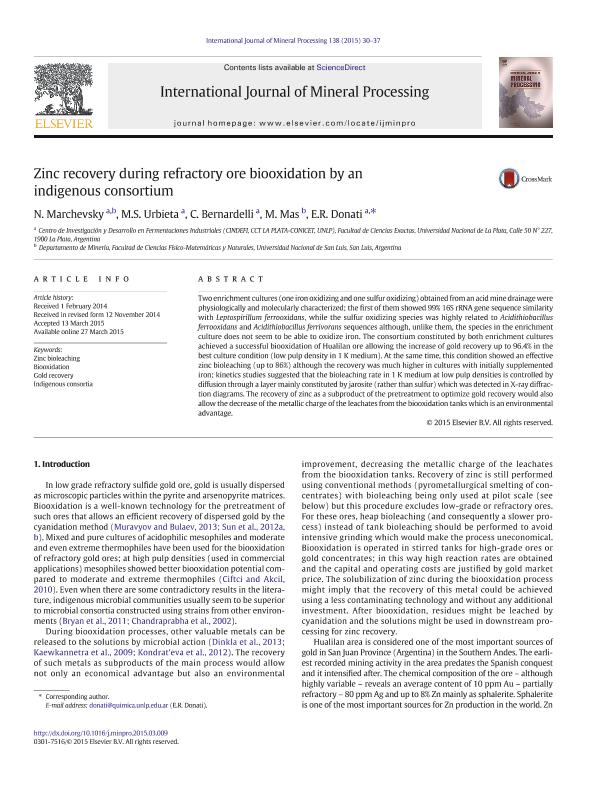Artículo
Zinc recovery during refractory ore biooxidation by an indigenous consortium
Marchevsky, Natalia Judith ; Urbieta, María Sofía
; Urbieta, María Sofía ; Bernardelli, Cecilia Elena
; Bernardelli, Cecilia Elena ; Mas, M.; Donati, Edgardo Ruben
; Mas, M.; Donati, Edgardo Ruben
 ; Urbieta, María Sofía
; Urbieta, María Sofía ; Bernardelli, Cecilia Elena
; Bernardelli, Cecilia Elena ; Mas, M.; Donati, Edgardo Ruben
; Mas, M.; Donati, Edgardo Ruben
Fecha de publicación:
05/2015
Editorial:
Elsevier Science
Revista:
International Journal Of Mineral Processing
ISSN:
0301-7516
Idioma:
Inglés
Tipo de recurso:
Artículo publicado
Clasificación temática:
Resumen
Abstract Two enrichment cultures (one iron oxidizing and one sulfur oxidizing) obtained from an acid mine drainage were physiologically and molecularly characterized; the first of them showed 99% 16S rRNA gene sequence similarity with Leptospirillum ferrooxidans, while the sulfur oxidizing species was highly related to Acidithiobacillus ferrooxidans and Acidithiobacillus ferrivorans sequences although, unlike them, the species in the enrichment culture does not seem to be able to oxidize iron. The consortium constituted by both enrichment cultures achieved a successful biooxidation of Hualilan ore allowing the increase of gold recovery up to 96.4% in the best culture condition (low pulp density in 1 K medium). At the same time, this condition showed an effective zinc bioleaching (up to 86%) although the recovery was much higher in cultures with initially supplemented iron; kinetics studies suggested that the bioleaching rate in 1 K medium at low pulp densities is controlled by diffusion through a layer mainly constituted by jarosite (rather than sulfur) which was detected in X-ray diffraction diagrams. The recovery of zinc as a subproduct of the pretreatment to optimize gold recovery would also allow the decrease of the metallic charge of the leachates from the biooxidation tanks which is an environmental advantage.
Palabras clave:
Biooxidation
,
Gold Recovery
,
Indigenous Consortia
,
Zinc Bioleaching
Archivos asociados
Licencia
Identificadores
Colecciones
Articulos(CINDEFI)
Articulos de CENT.DE INV EN FERMENTACIONES INDUSTRIALES (I)
Articulos de CENT.DE INV EN FERMENTACIONES INDUSTRIALES (I)
Citación
Marchevsky, Natalia Judith; Urbieta, María Sofía; Bernardelli, Cecilia Elena; Mas, M.; Donati, Edgardo Ruben; Zinc recovery during refractory ore biooxidation by an indigenous consortium; Elsevier Science; International Journal Of Mineral Processing; 138; 5-2015; 30-37
Compartir
Altmétricas



